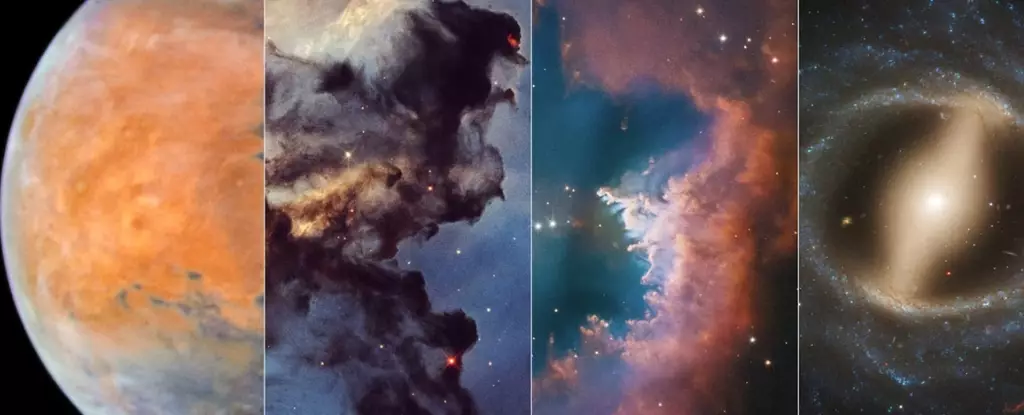This week, the astronomy community is abuzz with excitement as we celebrate the 35th anniversary of the Hubble Space Telescope’s launch. Rather than waiting for gifts, the Hubble team has chosen to share its cosmic treasures with the world, providing stunning images of celestial phenomena that continue to captivate our imaginations. Launched aboard the space shuttle Discovery on April 24, 1990, Hubble has become synonymous with groundbreaking astronomical discoveries. This milestone is not just a celebration of Hubble’s past, but also a reflection of its ongoing legacy and influence as a flagship observatory for NASA.
Shawn Domagal-Goldman, acting director of the Astrophysics Division at NASA Headquarters, aptly encapsulated Hubble’s significance by stating that the telescope opened “a new window to the universe.” Since its deployment, Hubble has not only transformed our understanding of the cosmos but has also inspired generations of astronomers and space enthusiasts. Its continuous operation into the present day demonstrates the immense value of maintaining and servicing such instruments, providing critical insights that will shape future exploration initiatives like the Habitable Worlds Observatory (HWO).
A Rocky Start But a Stellar Journey
Hubble’s journey wasn’t always smooth sailing. Following its successful launch, scientists soon discovered a significant flaw in its primary mirror, which initially hindered its imaging capabilities. In 1993, during the first of several servicing missions, astronauts corrected the defect, unlocking Hubble’s potential to deliver breathtaking views of the universe. This repair not only exemplified human ingenuity but also represents one of the most pivotal moments in the history of space exploration. Subsequently, Hubble’s observations have reshaped our grasp of fundamental astrophysical concepts, including the existence of dark energy, the acceleration of the universe’s expansion, and the tantalizing characteristics of exoplanets.
More than just a scientific tool, Hubble has served as a cultural icon. With nearly 1.7 million observations and over 22,000 research papers attributed to its findings, it has entrenched itself into the public’s consciousness. The awe-inspiring images produced by the telescope have invited the world to witness the wonders of the universe, bridging the gap between rigorous scientific research and everyday curiosity. Even as questions loom regarding its future due to periodic operational issues, the outpouring of public support garnered from previous challenges has invigorated NASA’s commitment to maintaining Hubble in working order for as long as possible.
Marvels from the Deep Cosmos
As part of the anniversary celebrations, the Hubble team has released new captivating images that illustrate the telescope’s broad observational range. Among these are vibrant depictions of Mars captured late last December, showcasing its topography, including the orange Tharsis plateau and the ghostly clouds that swirl above the planet’s surfaces. The beauty of these snapshots goes beyond mere visual appeal; they serve as critical resources in our endeavors to understand Mars, an increasingly potent target for human exploration.
A glimpse into the Rosette Nebula, a stellar nursery residing 5,200 light-years away, highlights Hubble’s capacity to capture the intricate dance of star formation. Dark clouds of gas and dust tower across the image, offering a striking context that helps us grasp the processes that give birth to stars. Similarly, Hubble’s artistic representation of the planetary nebula NGC 2899 appears like a cosmic moth, revealing the intricate interactions between stellar winds and radiant energy. Such visual narratives don’t just reveal the mechanics of the universe; they evoke an emotional response, reminding us of the sheer beauty and wonder residing beyond our atmosphere.
Furthermore, the stunning image of the spiral galaxy NGC 5335 offers insight into the complex structures that regulate star formation. Hubble’s ability to track gas flow to the galaxy’s core and the surrounding areas serves to further our understanding of galactic evolution.
The Dawn of a New Era: Transitioning to the James Webb Space Telescope
As Hubble revels in its anniversary glow, it also faces a gradual shift of focus towards emerging technologies, notably the James Webb Space Telescope (JWST). Launched in 2021, JWST is designed to surpass Hubble’s capabilities by capturing infrared wavelengths, an aspect critical to unveiling some of the universe’s most obscured secrets. However, the shift does not minimize Hubble’s legacy; rather, it heralds a new chapter in astronomical exploration.
The future projects like HWO aim to incorporate lessons learned from Hubble’s history, ensuring astronomers have the tools they need to probe exoplanets for signs of habitability. There’s a marked emphasis on robotic servicing capabilities for HWO, which reflects the recognition that addressing hardware challenges promptly can extend the productive life of costly observatories.
The exhilaration surrounding Hubble’s accomplishments over the past three and a half decades serves as a compelling reminder of our limitless pursuit of knowledge. The awe-inspiring images and revolutionary discoveries it has undertaken stand as testaments to the human spirit’s unyielding desire to explore the mysteries of our universe.


Leave a Reply